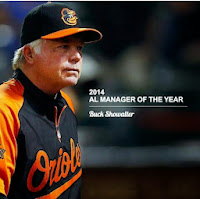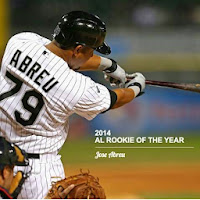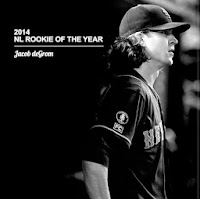-2014 American League MVP Award
Mike Trout's elusive career long chase for the American League is over!!!! Granted this is only his fourth season in the league, but after playing the bridesmaid the last two seasons to the two-time AL MVP Miguel Cabrera, Trout brings the trophy home to New Jersey having received all 30 first place votes. In doing so, Trout at the age of 23 is the youngest to win the AL MVP in unanimous fashion.
Trout received all 30 first-place votes and 420 points. Victor Martinez of the Detroit Tigers came in second with 229 points and Michael Brantley of the Cleveland Indians came in third with 185 points. The voting was conducted by the Baseball Writers' Association of America.
Trout is first player to win the AL award unanimously since Ken Griffey Jr. did so in 1997. Trout is the second ever to win it after two consecutive second-place finishes. Mickey Mantle was the first to do so with his runner up seasons for AL MVP in 1960-1961 and his MVP season of 1962 (Mantle had already won the award twice back-to-back in 1956-1957).
Trout is the third Angels player to win the MVP award after Don Baylor in 1979 and Vladimir Guerrero in 2004.
Looking at Trout's statistics, I find something interesting.
Could this be the first time that an MVP award winner has a season with significantly lower numbers than his previous runner up season? Look at Trout's statistics, courtesy of Baseball Reference's Mike Trout page:
This is no way saying that Trout did not have an MVP type season. He definitely did. But there is no denying that his numbers dropped compared to his freshman and sophomore seasons. While Trout had the same number of doubles and triples this season and he hit 9 more home runs and drove in 14 more runs in 2014 (36/114) than he did in 2013, he a had glaring drop in batting average from .323 to .287. He had more at-bats this season than last (602-589) but also had less hits this season compared to last season (173-190). Trout led the league in both runs scored (115) and total bases (338).
What stands out to me is the significant rise in strikeouts. Where Trout was consistent in the 130 strikeout range in 2012 and 2013, he struck out 48 more times to finish at 184. At the same time, his walks dropped from 110 in 2013 to 83 in 2014. His slash line (.377/.561/.939) while consistent in the Slugging Percentage portion ..557-.561 his on base percentage dropped from .432 to .377.
Again, I'm not saying Trout didn't have an MVP time season. He did. Could the dips in his stats be a one season thing or is it a sign of things to come. Maybe pitchers have found a weakness in Trout's armor? Who really knows but it is something that has been mentioned before. Ben Lindbergh's article Scorsese’s Oscar: Mike Trout Finally Won the MVP, But Could He Already Be in Decline? from Grantland.com dated November 14, 2014 touches on this and other potential factors for Trout winning the 2014 MVP award. Its definitely an interesting read.
- Click Here to access Mike Trout's career statistics from Baseball Reference.com
- Click Here to access the article Angels' Mike Trout, 23, wins MVP from ESPN.com dated November 13, 2014
- 2014 National League MVP Award
After I thought I couldn't say anything more about the two-time reigning National League Cy Young Award Winner Clayton Kershaw, wouldn't you know I forgot three letters: M.V.P.!!!! I know this pisses off many purists who don't think a pitcher should win the Most Valuable Award since pitchers have their own specific award: the Cy Young Award. Well, technically the hitters have their own award as well, known as the Hank Aaron Award. According to MLB.com's listing for Hank Aaron Award Winners:
Awarded annually to the best overall offensive performer in both leagues, the award was introduced in 1999 to mark the 25th anniversary of Hank Aaron breaking Babe Ruth's all-time home run record. Aaron, along with a panel of other Hall of Famers, determine the winners along with a fan vote.Giancarlo Stanton was the 2014 recipient of the award. So based on that, the MVP is open to all players. Even pitchers. Hate to disappoint the purists but not only is Kershaw two-time reigning National League Cy Young Award Winner but now he is also the 2014 National League Most Valuable Player.
 Kershaw received 18 out of 30 first-place votes and 355 points to win the award. Giancarlo Stanton of the Miami Marlins came in second with 8 out of 30 first-place votes and 298 points with Andrew McCutchen of the Pittsburgh Pirates coming in third with 4 out of 30 first-place votes and 271 points. The voting was conducted by the Baseball Writers' Association of America.
Kershaw received 18 out of 30 first-place votes and 355 points to win the award. Giancarlo Stanton of the Miami Marlins came in second with 8 out of 30 first-place votes and 298 points with Andrew McCutchen of the Pittsburgh Pirates coming in third with 4 out of 30 first-place votes and 271 points. The voting was conducted by the Baseball Writers' Association of America.Kershaw is the first NL pitcher to win both the Cy Young and MVP awards in the same season since Bob Gibson achieved the feat in the magical year of 1968. He is the fourth National League pitcher overall to do so with Dodger pitchers Don Newcombe doing it first in the history of MLB in 1956 and Sandy Koufax in 1963. Kershaw is also the first pitcher league-wide since Justin Verlander to win the Cy Young and MVP in the same season since 2011.
With his third NL Cy Young Award in four years and now the 2014 NL MVP Award in his trophy case, Kershaw is making himself quite the convincing case of being the best in-season starting pitcher of our generation, all at the tender age of 26.
- Click Here to access Clayton Kershaw's career statistics from Baseball Reference.com
- Click Here to access the article Clayton Kershaw wins NL MVP from ESPN.com dated November 14, 2014
Both league MVP are under the age of 30 and the sky is the proverbial limit on what we can see both players do in the years to come.
Until Then Keep Playing Ball,
Baseball Sisco
#baseballsisco
#baseballsiscokidstyle






































